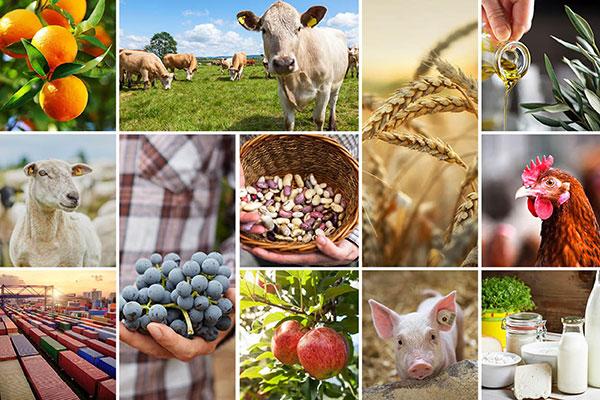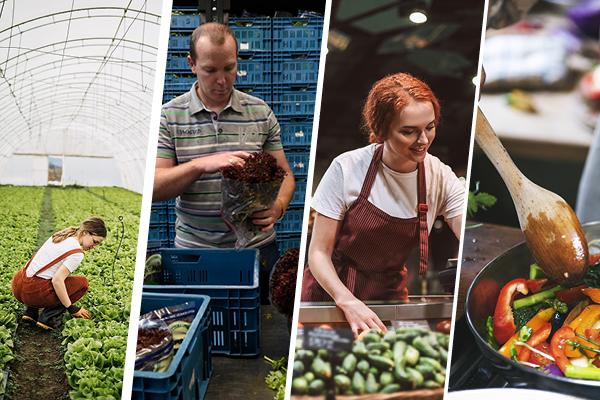
Hot and dry weather coupled with rainfall surplus in several parts of Europe during summer 2023 continued testing farmers’ resilience. Yields of different arable and specialised crops were affected, harvests were delayed, pests and diseases developed, and the quality of some products suffered too as a result. At the same time, there have been signs of positive market prospects for the EU agricultural sector. The costs of input, like energy, fertilisers and feed, continued to decline. EU exports of agri-food products regained some competitiveness, confirming the EU’s position as the world’s top exporter. Published today by the European Commission, the autumn 2023 edition of the short-term outlook report for EU agricultural markets presents the latest trends and prospects for agricultural markets.
The monthly food inflation started to decline since July in the EU. While food prices still remain a big concern for consumers, this might bring some relief in the demand for certain products. In general, food inflation accounts for almost 40% of price increases at consumer level. Wine is one of the products for which consumption dropped due to higher prices, coupled with structural decline of the consumption of red wines. The crisis distillation, authorised this summer by the European Commission, is helping to stabilise the market.
Meat is as well affected negatively by a drop in consumption due to high prices. Improved grassland conditions, as well as lower feed costs, provided some relief to livestock producers. However, meat production, with the exception of poultry, could remain below average.
Soaring EU prices of nitrogen fertilisers prevented a general shortage and uncontrolled lower use of fertilisers by EU farmers. The Commission has been closely monitoring the fertilisers’ market and launched in July 2023 the EU Fertilisers’ Market Observatory.
Arable crops
The EU cereal production for 2023/24 is expected to be 4.3% below the 5-year average, at 268.5 million tonnes, due to the adverse weather conditions over spring and summer that especially impacted maize and barley production. Feed use of cereals could remain stable while the use of cereals for biofuel production could continue growing (12% above 2022/23). The EU continues to be a net exporter of cereals, notably wheat. Exports to the Middle East and Sub-Saharan Africa have particularly increased in the previous months.
The EU oilseed production is doing particularly well (11% above 5-year average), driven by a recovery in sunflower production, as well as higher soya bean production.
While the complete ban on the use of neonicotinoids causes some challenges for sugar beet growers, planting areas, beet yields, and sugar content are expected to increase compared to the decline recorded last year. The 2023/24 EU sugar production is forecast at 15.6 million, close to 5-year average.
Specialised crops
The production of olive oil will remain low and is not expected to fully recover in 2023/24. Prices will remain high, resulting in lower exports and EU consumption. In certain regions, the prices are almost 3 times higher compared to the 5-year average. Stable imports could to some extent support EU availability which will nevertheless remain low.
The EU wine production in 2023/24 is forecast to decline by around 6%, mainly because of a drop in Italian and Spanish production. Consumer demand, notably for red wine, continues declining. Consumers have a lower purchasing power, and shift to other beverages, like beer.
Impacted by unfavourable weather, the production of apples and oranges will see a similar declining trend, with around 2% less compared with last year. More fruits are also likely to be used for processing due to lower quality and higher storage costs.
Milk and dairy products
EU milk deliveries remain rather stable and are estimated to increase by 0.3% in 2023. The prices of EU raw milk have been declining since the beginning of the year. Even though energy, fertilisers and feed costs are slowly starting to decrease, they remain high, thus leading to tight margins for EU dairy farmers.
The production of cheese is forecast to be 1% higher in 2023 than last year. Easing EU food inflation is likely to have a positive impact also on domestic use (+0.2%). Beyond expectations, production of fresh dairy products is increasing (cream and drinking milk). As EU exports are unlikely to expand due to decreasing demand in China, extra volumes are likely to be consumed domestically, showing a higher resistance to increasing prices than other products of animal origin.
Meat products
Europeans will continue eating less meat. Overall, per capita meat consumption in the EU is expected to go down by 1.5% in 2023 due to price inflation and lower supply on the market. The decrease is stronger for beef consumption (-3.5%) and pigmeat (–5.2%) while consumption of poultry meat will grow by 4.3%.
Prices for beef and poultry remain high, due to lower supply. Supported by a recovered production, poultry stays one of the cheapest animal protein sources for consumer.
EU sheep meat production is expected to suffer from a structural declining sheep flock, lower grass availability, especially in Mediterranean countries, higher costs for feed and the outbreaks of sheep pox in certain countries.
Updated balance sheets for the marketing year 2023/24 are included in the latest short-term outlook report and are also available in the agri-food data portal.

The short-term outlook for agricultural markets is published three times per year and is based on the latest data and information from market experts in the European Commission.
Details
- Publication date
- 9 October 2023
- Author
- Directorate-General for Agriculture and Rural Development
- Location
- Brussels




